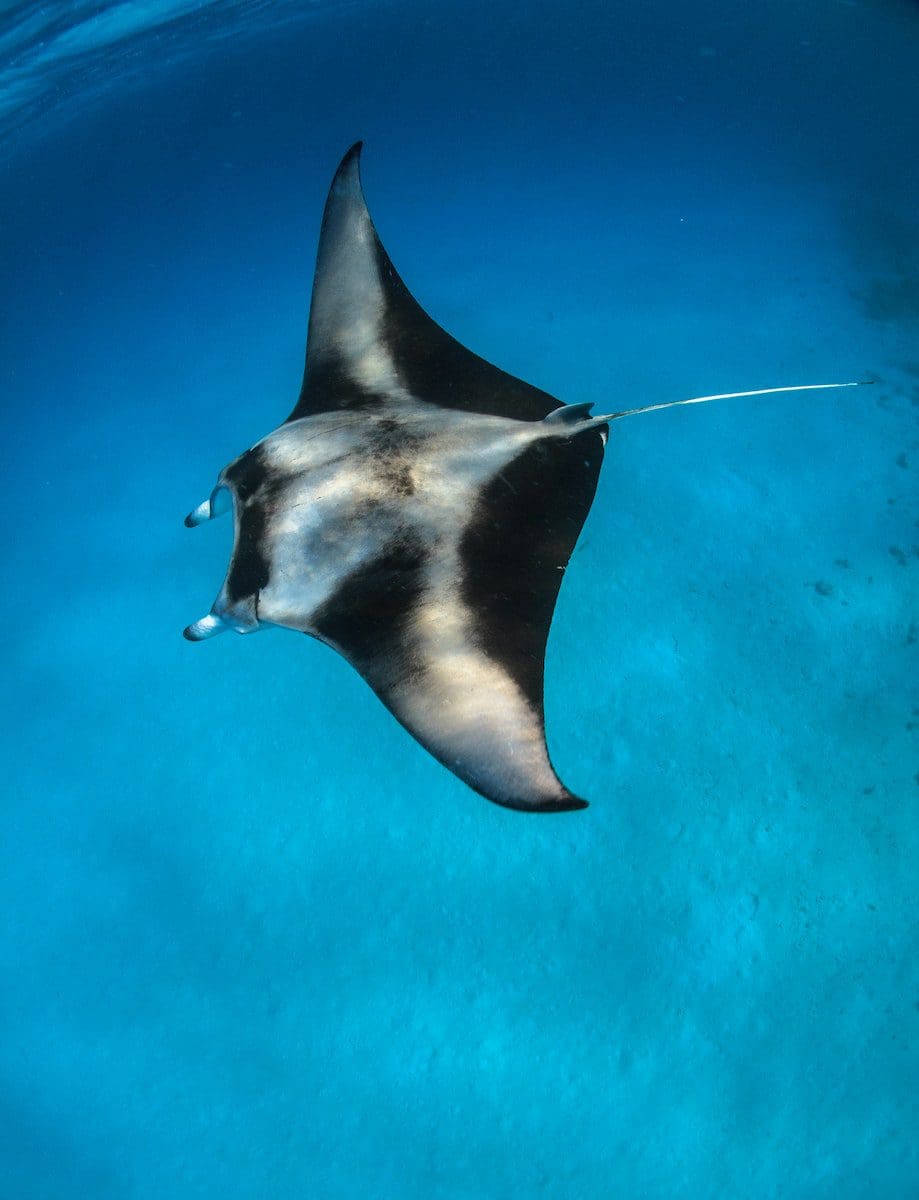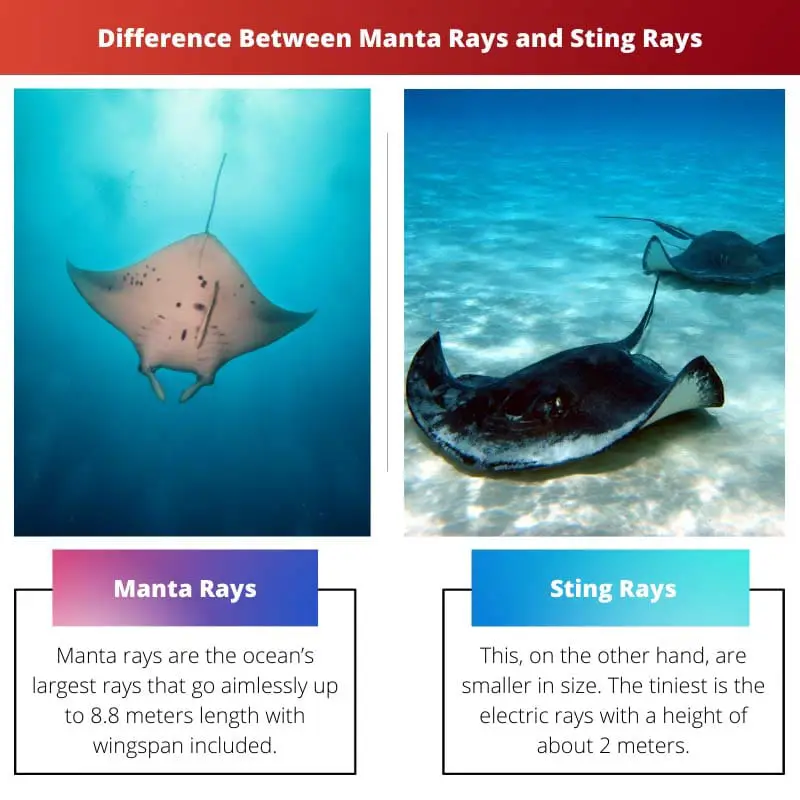Marine life is gorgeous, and there is no way to describe its beauty.
People who can honestly describe the beauty of the sea are Marine biologists and ocean zealots who are forever in endless surprises because they are the ones that study what’s deep down under the ocean and the life that exists within.
Hundreds of different species under the ocean go unnoticed by the naked eye. All creatures that live deep beneath the waters have diverse survival conditions based on their shape, texture, etc.
Most sea creatures are found in tropical, temperate, and subtropical regions for survival.
One such ocean creature is the ‘ Ray fish‘, which is highly intelligent but life-threatening to humans or any other living organism. There are different types of ray fishes, but here we would be talking about only 2 types: Manta Rays and Stingrays.
Key Takeaways
- Manta rays are large, gentle marine animals with wing-like fins and wide, flat bodies that feed on plankton and small organisms without a stinging barb on their tail.
- Stingrays are a diverse group characterized by their flat, diamond-shaped bodies, living close to the ocean floor, and possessing a venomous barb on their tail used for self-defense.
- Both manta and stingrays are cartilaginous fish belonging to the same subclass but differ in size, feeding habits, and the presence or absence of a stinging barb.
Manta Rays vs Sting Rays
Manta rays are the largest fish in the world, with a width of up to 8.8 meters, and are found in saltwater. They float above the water. Sting rays are minor rays with a width of 2 meters that are located in placid tropical waters and shallow marine waters but deep in the water core.

Both these Ray fishes are similar morphologically but still have a considerable differences in traits and functions. Interestingly, rays are closely related to sharks because they both are made of cartilage and have no bony skeleton.
Moreover, like sharks, they do not use their eyes to prey. Instead, they use the electro-sensors that help them find their prey easily in the water.
Manta Rays are stunning creatures but are confused with Stingrays due to their similar looks. There’s a vast catalogue of differences that separate them from one another.
Comparison Table
| Parameter of Comparison | Manta Rays | Sting Rays |
|---|---|---|
| Tail barb | Manta rays do not acquire stinger or bard at the end of their tail | Stingrays do acquire barbs on the tail. Some of the stingray’s bards are venomous too |
| Size | Manta rays are the ocean’s most enormous rays that go aimlessly up to 8.8 meters in length with wingspan included. | These, on the other hand, are smaller in size. The tiniest is the electric rays with a height of about 2 meters. |
| Mouth site | Manta rays have their mouths on the front side of their body | The stingray’s mouth is located underneath the body. |
| Territory | Saltwater | Warm, placid waters, Marine water |
| Drift | Manta rays can be seen floating as they stay above the water ground. | Stingrays always dwell at the bottom of the water’s surface. |
What is Manta Rays?
Manta rays are the largest fishes that exist on the earth. They are the largest among their family species, having a width of up to 8.8 meters along the wingspan.
These manta rays are located in tropical and subtropical regions where they can be watched offshore the ocean or near the coastlines.
A giant manta ray could weigh approximately 5000 pounds(2000 kg) or near. With such a vast weight, they can swim 1000 meters underwater but keep it low to about 10 meters to get food quickly.
Due to their horn-like cephalic flaps in the mouth, they are also recognized as Devil rays. Although they have enormous bodies, they are harmless in many senses.
There are 2 different types of manta ray species, i.e. birostris and M.alfredi; they are classified in the Myliobatidae tribe of sea rays.
Both these species have almost the same morphology as they are cartilaginous, which means they are made up of cartilage and no bone, just like human ears and nose, kite-like pectoral fins, and horn-shaped fins.
The factor that distinguishes these two is their size. Birostis has a width of up to 7m, which is longer than M.alredi, which reaches up to 5.5m in width.

What is Sting Rays?
Stingrays are the minor rays on the planet, having a width of 2 meters and 35cm in length. These rays are located in shallow marine and placid tropical waters.
They cannot be seen offshore as they dwell deep within the water core.
The stingrays weigh 750 pounds and have a lifespan of about 15-25 years. The camouflage colouration of stingrays reflects floor colour so they can be saved from predators and fetch their prey.
Stingrays are brilliant sea creatures who search for food not simply by their eyes; they have special sensors called Ampullae of Lorenzini. This particular sensor helps them detect their prey by sending electrical signals under the water.
Surprisingly, stingrays are the oldest sea rays that have existed since Jurassic Park, about 150 million years ago. But unfortunately, these stingrays are facing extinction due to many climatic conditions and water deterioration reasons.

Main Differences Between Manta Rays and Sting Rays
- Stinger: Manta rays do not have a bard or stinger on their tail, whereas stingrays have 2 or more barbs. These stingers are only for self-defence purposes which they use only when they sense any predator.
- Mouth: The mouth of the manta ray is located in front of their bodies. On the order hand, stingrays have their mouth located underside of their body. This is the most significant difference based on which you can tell the type of rays.
- Water dwelling: Devilfish are pelagic and prefer to stay above water levels, whereas stingrays prefer to dwell at the water’s surface. Though manta rays are massive, they tend to swim near the coastlines, but stingrays being tiny and thin, choose to live under the water’s surface.
- Toxin: Manta rays could be seen human-friendly as they are harmless and can be touched without getting hurt. But stingrays are the deadliest; they have venom-filled body sacs which they use in self-defence.
- Nutriment: Manta rays are filter feeders that feed on zooplankton like small fishes. At the same time, stingrays are bottom feeders and feed large sea species like shrimps, crabs, etc.

- https://onlinelibrary.wiley.com/doi/abs/10.1002/(SICI)1097-4687(200002)243:2%3C113::AID-JMOR1%3E3.0.CO;2-A
- https://www.publish.csiro.au/mf/mf08301

This article is a treasure trove of knowledge about Manta Rays and Stingrays, providing a captivating glimpse into the mysteries of the ocean’s depths.
It’s truly fascinating to unravel the nuanced differences between these magnificent sea creatures.
The article skillfully showcases the distinctive characteristics of Manta Rays and Stingrays, creating a truly engaging narrative.
The captivating portrayal of these marine creatures is both enriching and thought-provoking.
Indeed, the comparative analysis adds a layer of intrigue to the discussion.
The comprehensive details about Manta Rays and Stingrays are presented with an engaging narrative, making it a commendable read.
The author manages to evoke a sense of wonder and appreciation for these fascinating sea creatures.
The article strikes a balance between scientific information and captivating storytelling.
While the article offers valuable insights, I wish it delved further into the ecological and environmental impacts of these sea creatures.
Agreed, addressing conservation aspects would provide a holistic view of the topic.
That’s a valid point, understanding their role in the marine ecosystem and conservation efforts would enhance the article’s depth.
The author adeptly captures the enchanting beauty and distinctive characteristics of Manta Rays and Stingrays, rendering the article both captivating and informative.
This insightful piece encapsulates the mesmerizing allure of marine life, leaving readers spellbound.
The article offers a compelling exploration of the intricate features and behaviors of Manta Rays and Stingrays, fostering a deeper understanding of these captivating creatures.
The author portrays marine life with a sense of wonder and admiration, making it an enjoyable and educational read.
Absolutely, the artful description of the sea creatures is both delightful and informative.
The article provides an in-depth and insightful analysis of the differences between Manta Rays and Stingrays. A fascinating read for marine life enthusiasts.
Very informative indeed, it sheds light on the lesser-known aspects of these creatures.
I agree, the details about their morphology and behavior are truly captivating.
The eloquent description of Manta Rays and Stingrays transports readers to the enchanting realm of the ocean, shedding light on its captivating inhabitants.
The seamless blend of scientific insights and poetic imagery in the article enhances its literary appeal.
Indeed, the author’s vivid portrayal of marine life is both captivating and educational.